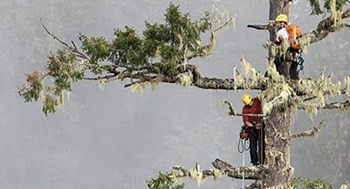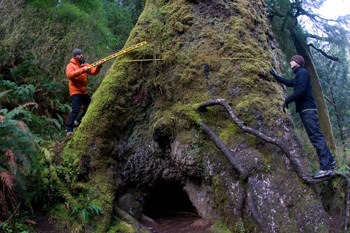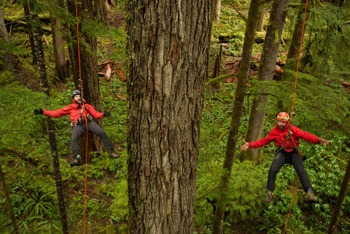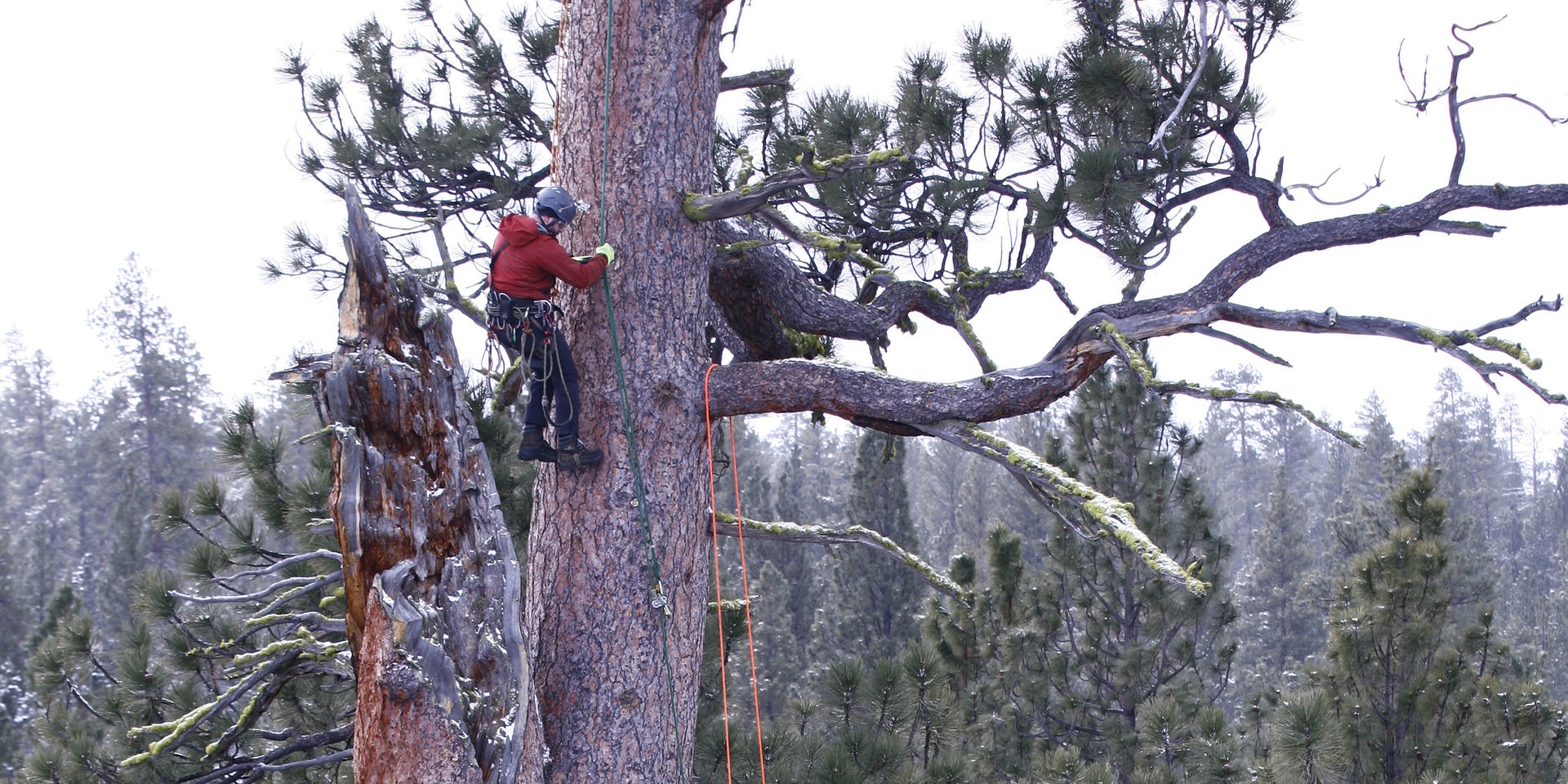You are here
An integral part of sharing the iconic trees that make the West Coast of North America special is telling the story of the giant trees of each species. An Oregon-based organization called Ascending the Giants is on a mission to do just that. Ascending the Giants is a 501(c)3 non-profit organization that produces an ongoing series of expeditions to measure the largest trees of each species. These trees demonstrate the pinnacle of what a species can be; they are called champion trees.

We had a chance this past week to sit down with Brian French and Damien Carré, two members of Ascending the Giants, to hear their story.
OUTDOOR PROJECT: When did people start cataloging champion trees?
BRIAN: At ATG we started cataloging champion trees in 2007, around the time of the group’s inception, but champion trees have been documented for state registries throughout the US since the early 1940s. Oregon’s registry had suffered a major loss in funding before ATG committed to measuring and documenting these relics. In 2009, Ascending the Giants adopted oversight of the Oregon Champion Tree Registry from the Oregon Department of Forestry. The entire archive since 1941 has now been digitized by the organization and work of Ascending the Giants Data Manager, Jerry Black.
OUTDOOR PROJECT: How do you find the champions? Are you out searching the forests or are you using more hi-tech tools to find these huge trees?
BRIAN: Most of the trees in our registry have been nominated by the public, primarily by hikers, hunters, fishermen and outdoor enthusiasts. Public participation is critical for the success of our program and for the conservation efforts needed to keep these trees around. But we also now have the technology to use the aid of LIDAR, satellite mapping, GIS and flying drones to seek out more answers about champion trees.
OUTDOOR PROJECT: So how do you measure the champions? Is it the tallest, the widest crown, the oldest, or a combination of metrics?

BRIAN: Champion trees are measured using the American Forests points (AF points) which is calculated based on a combination of the trunk circumference, the tree's height, and the average crown spread to give a point value. A tree's height doesn't necessarily make it the champion. Take Hyperion, for example, the world's tallest known redwood. It's approximately 700-800 years old. By comparison, the oldest known currently living redwood tree is over 1,500 years old. Many large trees may grow tall in their youth, but as they age, they'll increase in trunk diameter and volume while an event in their lifecycle may cause their top to break off. In a sense, it's a bit like people. When we're still relatively young we grow our tallest, and then we round out as we age.
OUTDOOR PROJECT: Great analogy. How many trees are there in the Champion Tree Registry? Has each been verified by an ATG team member?
BRIAN: Currently we have approximately 120 species listed in our registry. This is approximate because there are a couple of potential taxonomy changes that have been in the works for a few years. Since verifying the first tree through ATG in 2007, we have verified nearly all of the listed champions.
A few of the trees are so remote that they require several days to get to, and in most cases we encourage hikers to visit these trees. We disclose location information on our website for many of the trees that can be visited by the public and hope to add these as trips on Outdoor Project very soon too. However, for some champion trees, we don't give out the location. Not all champion trees are on public lands, and some are in very sensitive habitats, requiring us to keep location information confidential.
OUTDOOR PROJECT: Well we're excited to work with you to share information on how people can visit the giants that are publicly accessible. ATG also does a lot of international work. Is it your goal to document the champions of all tree species?
BRIAN: For a few people to do that amount of work would be impossible, but it is something we’d like to see happen. We’ve done the calculation by taking all the species on earth and then looking at the number of years in our collective life expectancies as ATG team members, and it comes down to seven trees a day we’d have to measure as an organization for the rest of our lives. So measuring champion trees is much bigger than Ascending the Giants. It’s an amazing lesson we’ve learned that people are already valuing and cherishing the trees in their area, wherever it may be, and there is usually a forester in areas such as Indonesia who is really down to earth, cares about their environment, and knows multiple people who know where other large trees are located. We hear stories where the children’s children’s children knew that their great grandparents used to go up to a particular large or old tree to acknowledge its presence. Caring about champion trees is not something that we only have here in Oregon. Other people throughout the world also have that. So searching for that, sniffing it out, and then showing our model and what we’re trying to do here will also hopefully encourage other organizations and governments to do something similar.
We’re connecting with different organizations that are similar to ours, working in population centers in the more westernized countries, like Australia, New Zealand, even Singapore. We spent quite a bit of time in Hong Kong, mentoring and connecting with people there. One of the groups that we're working side-by-side with is from New Zealand. Their champion tree program is called the Notable Trees of New Zealand and uses a similar measurement system. Will has also spent some time in Borneo on a research project, but it takes six months to a year to plan a week-long trip in one of those areas, and that takes a lot of funding.
OUTDOOR PROJECT: I'm guessing that since 2007 you've had some incredible experiences in giant trees. Are there any special moments you're particularly fond of?
BRIAN: Well, one of our highlights to this day was an expedition to climb, measure and film the measuring process of the world’s tallest Douglas fir tree, the Brummitt Fir. The tree measured to be 327 feet (pictured at left, photo by Darryl Lloyd). 
As climbers we knew that the crowns of these trees had not likely been explored and we were all curious about our finding, so after collecting measurements and photographs, we contacted our friends at Oregon State University. It turns out that up until our discovery this species had only ever been reported as high as 90 feet aloft, and this former figure was not considered to be significant due to the fact that only a lone male was recorded. So our finding was a huge discovery. Our encounter was published in the National Herpetological Review by one of our team members, Bill Price, and it's now speculated, thanks to this mating pair, that certain Clouded Salamanders may live, reproduce and expire exclusively within a tree’s crown. With that in mind, it's a distinct possibility that this long lived, towering tree offers suitable if not optimum habitat for the salamander pair.
OUTDOOR PROJECT: Wow, what an incredible experience. That brings up the question of impacts that you can also have on these isolated and untouched habitats when doing your work. How are you minimizing the human impact? Can you leave no trace when measuring a giant?
DAMIEN: Great question. The reality is, no matter what, you will always leave a trace. Our goal is to minimize it as much as possible, and share the approach with others.
BRIAN: Damien is right. There is always an imprint of something left behind, but with the equipment we do use, we’re very careful about the impacts. Rather than use rope directly over the branch, we have insulated tubing that runs over the branch and so as we’re moving back and forth on the rope over the branch, it’s not creating friction and burning through the cambium. We never spur a tree, even as arborists. That’s a standard practice for loggers when cutting down trees, and I think a lot of people confuse a logger and arborist as the same thing. We use a lot of methods more similar to rock climbing. We never anchor into a tree or screw anything into a tree. We use branches and branch collars as our anchors, which are all retrievable. We use those points to climb on, but we always have to reassess while we’re climbing because we’re climbing on a living organism.
DAMIEN: We realize that most of these champion trees, trees that are three to five hundred years old, have never had any impact in general, beyond the elements and some birds. But when you get a 150 pound plus person climbing through there, there’s impact, so we strive for the least impact possible.
BRIAN: Most of the champion trees we go out to measure are some of the oldest trees for that species, and most of the ascents when we go out to measure these champion trees are first ascents, so we don’t want to go up there and change or modify anything, we want to go in there, do our measurements, and then get out leaving the tree exactly as we found it.
OUTDOOR PROJECT: I think many of us feel this intuitively, but in your view how does creating this champion registry translate to a deeper commitment to protecting forests in general?
BRIAN: Fundamentally I think people need to get out and touch, feel, see and smell and use their senses in the forest to develop a love of it. You can’t fully connect with a forest just by looking at photos or reading a story. And that’s where Outdoor Project and Ascending the Giants have missions in unison. We’re displaying this information because it’s intriguing, beautiful and fascinating, and we want to entice people and introduce them to these special areas. Our job at ATG is to seek out, find and protect these areas, but another part of our job is to link people to these areas so that our website, and the work we’re doing with Outdoor Project, will give more people the tools to get outside to enjoy the forests and hopefully understand them better. I never hear anyone complaining when we're out in the trees. No one says: “Why did the tree grow like that. That’s just terrible.” It’s always a fascinating thing. People want to investigate. I don’t think it’s a matter of asking why do we at Ascending the Giants think trees are important, or why do we think that other people connect better with trees because of our work. Every single person has an answer in themselves, and all they need to know is how to get there.
DAMIEN: Everybody wants to feel connected with existence. By getting a view of what a tree or forest is like midway up or all the way up, everybody who has that experience comes down grinning from ear to ear. We have people tell us their life has been changed just getting half way up a canopy.
OUTDOOR PROJECT: As you talk it conjures up images of kids playing in trees. A kid climbing a tree is a universal symbol of discovery and freedom I think we can all relate to. Only you're taking it to the next level.

BRIAN: And we have a lot of fun doing it, but it's more than that, it's very meaningful. With trees I think everyone has a personal human-tree relationship already inside themselves. It's not something we at ATG need to explain. It’s kind of like asking somebody “Why do you think it’s important for people to know babies are cute?” I think everybody already knows babies are cute. Babies are cute. People just know this. Get into a tree and you'll have an answer for yourself.
On a more serious note, I see champion trees as playing an integral role in our forests' future. Just within the last century, our largest trees have been decreasing in size, along with our expectations of what a tree should be. We had trees that were much much larger in the Pacific Northwest just 100 years ago than we have now, both by diameter and by height. We think of the redwoods as the tallest tree now. The Douglas fir was actually a taller tree before. The tallest Douglas fir actually verified was 393 feet tall, with less reputable accounts claiming trees that were even taller. There may have been taller redwoods before that that were cut down, but as far as we know by the record, the tallest tree ever measured and actually recorded was a Douglas fir. The tallest Douglas fir we have now is 327 feet. Through development, land changes, fires, what have you, over the last century we’ve seen a huge decrease in the expectations of what a tree should be. In 2008 alone we lost three of the largest Sitka spruces, and now we have a several hundred year gap between the trees we have now to the trees that were once the largest. It’s daunting to look at that and to expect that our forests will ever look like they did before.
We’re spending our time and energy creating this documentation of the forests that we have now, and these ancient trees before they fall over and die, so future generations can look back and see what the world did look like when their grandparents were around, and hopefully inspire stewardship that allows for forests to grow back up to their former glory. It’s really going to be up to people at a later time, using the documentation and the knowledge that every species deserves. So in its distilled essence, we’re focusing on the archiving of our present champions with a goal to use that information to set the expectations as high as possible. We are a part of building nature’s encyclopedia and using our knowledge of the past to create a vision of the future potential of our forests.
Want to see more of Ascending the Giants? Check out this wonderful video of the organization filmed by Pro Photo Supply.





Comments
Sign In and share them.